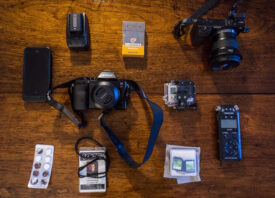Search this site
Photos Document Inhumane Prison Cages Housing Members of El Salvador’s Two Largest Gangs
New York-based British photographer Giles Clarke uncovers the inhumane conditions of El Salvador’s gang prisons in a series he calls Caged In El Salvador. The work, recently published as VICE Magazine’s August cover story, documents the literally ‘caged’ prisoners—30 or more—that are crammed into holding cells the size of a small room. In this excerpt, which originally appeared in VICE, Clarke breaks down his experience discovering and shooting the story, a disturbing and powerful one to say the least:
I traveled to a rough suburb 20 miles outside San Salvador and spent some time with a police captain and units charged with patrolling this particularly troubled area where both the M18 gang and MS-13 gang live and operate.
On my last day with the captain, I was chatting with him in the police station when he mentioned the severe overcrowding in the Salvadoran prison system. When I pressed him for more information, he offered to show me what he called the “gang cages” and escorted me to the back of the station flanked by four armed guards.
In a rancid, sweltering prison yard ringed by a high wall topped with barbed wire sat three cages. They stood about 12 feet wide and 15 feet tall—each crammed full of more than 30 human bodies. M18 and MS-13 each had their own cage, with the third reserved for “common criminals.” They were initially constructed to serve as 72-hour holding cells, but I was told that many of the inmates had been imprisoned in these pens for over a year. Most of their days are spent pulling apart their clothes and using the thread to sew together hammocks, where they sleep stacked on top of one another like cords of wood.
After my 40 minutes in the enclosure, the guards told me to leave. I asked the captain if I could return the next morning to talk to the prisoners further, and he agreed.
The following morning, however, I discovered that the cages were usually off limits to press. The captain told me that no photojournalist had been allowed to see the cages for over ten years, and word of my peek inside had somehow reached the San Salvador police’s press office. They weren’t happy, the captain told me, and apparently were on their way from San Salvador to “talk” to me. The guards had told Henry that I was barred from returning, and because these prisoners aren’t allowed visitors, he got very upset and started threatening them.
My situation was becoming more compromised by the second. The captain told me to leave immediately, before the head of the press office arrived. A few minutes later he had calmed down, and we had a friendly chat as he escorted me to my car. He was clearly troubled by the storm brewing but seemed somewhat resigned to it all.
Looking back, I think the reason the captain showed me the cages was because he was simply frustrated with the inhumane conditions that he must preside over on a daily basis, with no hope of the situation improving anytime soon. During most of our discussions, he brought up that there wasn’t even a budget for the inmates’ most basic necessities, like food, the cramped conditions, and the prisoners’ frequent health problems. “We need a full-time doctor here,” he said. “These cages are full and many are sick. Maybe your pictures can help in some way?” That was the last thing he said to me as I got into the car.
Two hours later, I was at the airport and checking in for my flight back to New York City.














